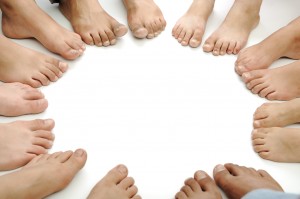

 Have you measured your feet today? What about last week? Chances are you haven’t measured them at all. Or you might have a rough idea of your shoe size because you had your shoes fitted several years ago but, as an adult, you never thought you needed to have them measured.
Have you measured your feet today? What about last week? Chances are you haven’t measured them at all. Or you might have a rough idea of your shoe size because you had your shoes fitted several years ago but, as an adult, you never thought you needed to have them measured.
What if I told you that your feet continue to grow after you hit adulthood? The rest of your body doesn’t, and over time we’re fighting the force of gravity as things start to sag or your back begins to hunch.
But there is a pretty good chance you’ve noticed your shoes getting tighter. But why? After all, you know your shoe size when you go the mall or order online. And with some of the bargains available at the click of a computer mouse, the hustle of the retail store seems less appealing than ever. Sure, you can’t try them on, but the deals! The variety! Well, if this is your train of thought, I’m about to burst your bubble.
RELATED READING: Take a closer look at your feet for health warning signs
A study of just over 2,000 men and women by the College of Podiatry in the United Kingdom in June showed the average shoe size has increased over the past three decades. The average shoe size in the 1970s was a size seven for women and most shoe manufacturers made shoes up to a women’s size 10. In 2014, the average female foot size has gone up to a size eight and shoes tend to be available up to a size 12, sometimes even larger. When it comes to men, shoes are now made up to a giant size 20, when in prior decades a size 15 was considered the biggest.
The reason has to do with the evolution of human height. Emma Supple from the College of Podiatry says, “We’ve all gotten taller and we need big feet to hold us up.” Our bodies are bigger, heavier and require more foot support.
But don’t confuse your feet growing with another foot issue: Adult acquired flatfoot deformity (AAFD) is a condition where your foot arch falls with age, causing pain and discomfort, not to mention the need for larger shoes. AAFD is seen in people with arthritis, foot fractures and diabetes.
It all seems reasonable, when you consider that a human grows and evolves through the years and the rest of the body needs to keep up. But that doesn’t account for another issue encountered during the course of the study – denial.
Researchers found that many women do, in fact, have a pretty good idea that their foot size has increased, yet they continue to buy shoes that are painful and don’t fit for the sake of fashion. Over half of the participants readily admitted that they will purposely buy the wrong size of shoe if the right size isn’t available or if the nicer shoes don’t look as appealing in a larger size. The main offender was women on the hunt for stiletto heels which tend to be uncomfortable regardless of the correct size.
RELATED READING: Why hip joint pain is more significant than you thought
With online shopping and bargain hunting being so common, people are far less likely to go the old-school route of setting aside time at the shoe store to have their measurements done properly and buying shoes that fit. But this might be to the peril of the person buying the shoes. A poor-fitting shoe can cause other ailments like blisters, cramping through the legs, ingrown toenails and even hammer toe.
A good rule to remember is that you should be able to wiggle your toes a little inside the shoe. If you can’t move your toes at all, the shoes could cause you more pain than they’re worth, no matter the bargain.
According to health resource NHS Choices, even the most sedentary person tends to take about 2,000 steps per day which equates to about a mile. The average active person walks about 10,000 steps per day, or the equivalent of five miles. If you look at it like that, taking the time to measure those ever-growing feet becomes extremely important.
Comfort needs to come before style! Your feet need to last you a lifetime.
Copyright © www.orthopaedics.win Bone Health All Rights Reserved